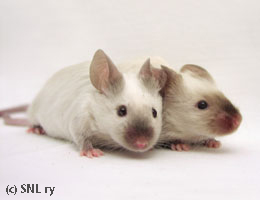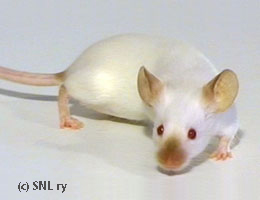Genetics
C-locus
6. Himalayan, ch
The himalayan gene (this is often referred to as the siamese gene, but the genetics have named it himalayan, thus the c"h") is a so called acromelanic gene. This means that the colour of the mouse depends on the warmth of the mouse's skin. Therefore the colder extremities (ears, nose, feet, tail) have more colour than the rest of the body. Everybody knows what siamese cats look like. The action of the mouse gene is similar. Furthermore, this gene reduces the depth of the eye colour. The gene has a strong effect on the yellow pigment, reducing it to white. That is why a mouse with the himalayan gene (other than coupled with C) cannot have any red / yellow pigment in the coat at all.
Homozygous Forms
6.1.1. ch with Ay
The effect of the himalayan gene on yellow pigment is so strong, that Ay/* - ch/ch mouse is white, with red to ruby eyes. With light eye colour, this looks like an albino, but (as all colours with the dominant yellow gene), they do not breed true, have 25% less offspring when mated together due to the lethal factor and suffer from obesity and related problems.

Siamese blue point, a/a ch/ch d/d |

Siamese chocolate point, a/a bc/* D/* |

Himalayan, a/a B/* ch/c |
6.1.2. ch with A
When the himalayan gene is coupled with the A, the result is mealy body colour and points. This is, of course, the result of the yellow (= golden brown) layer of pigment being diluted into white. The situation is same with cinnamon and blue agouti backgrounds as well.
6.1.3. ch with at
When the himalayan gene is coupled with the tan gene, the result is a fox belly on a otherwise siamese top colouring. It depends on the other gene this mouse has what the top colour is like, but the belly will be fox.
6.1.4. ch with a
Well, well. Now we're into something!? a/a B/* ch/ch is the well known siamese seal point (description is found on the? "shaded" page of Varieties). With a/a bc/* ch/ch you'll get the unstandardized siamese chocolate point mouse. This variety is similar to the seal point, except with lighter, softer and warmer colour. SCP hasn't been standardized anywhere but Sweden (to my knowledge, that is) as it does not differ enough from the seal point. a/a B/* d/d ch/ch is siamese Blue point (description is found on the? "shaded" page of Varieties), a variety that is clearly a dilution with the blue and silver shades. With a/a bc/* d/d ch/ch we have a siamese lilac point - another unstandardized variety. This is a rather pale version of the siamese, with even the points being quite pale.
6.2. Heterozygous Forms
6.2.1. ch with albino c
When the himalayan gene is combined with albino gene, the result is a himalayan mouse. This is a mouse with as white as possible body colour combined colour points, without shadings. In mouse standards different himalayan point colours have not been separated, but the standards allow the mouse to have points of any colour. Of course, red points are an impossibility and with the dominant red gene present the mouse will be a PEW.
With A/*, the points look "streaky" and "dirty", with a/a B/* the himalayan mouse has seal points, with a/a bc/* chocolate points, with a/a B/* d/d Blue points and finally with a/a bc/* d/d lilac points. The best looking himalayans have a/a B/* D/*, which gives the darkest points possible. Actually - the darkest points are achieved by the extreme nonagouti gene ae.
With at/* ... ch/c points don't extend below the lengthwise midline. This can be seen on the nose spot, which is "cut off" at jawline.
